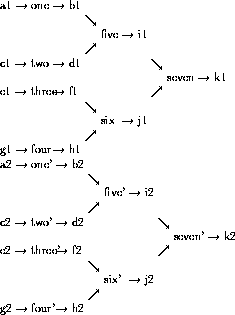 and an
initial state
and an
initial state  , and global goals
, and global goals  . One to five are
the competence modules necessary to achieve goal
. One to five are
the competence modules necessary to achieve goal  , while one' to five' are
the modules that contribute to goal
, while one' to five' are
the modules that contribute to goal  .
.



The algorithm demonstrates an implicit bias mechanism. It favors modules that contribute to the ongoing goal and subgoals except when there is enough urge to start working on something different. The main reason bias is exhibited is that the activation levels are not reinitialised every time a module is activated. As a consequence the history of past activation spreading plays a role in the selection of action, in particular when the effect of the state and goals is relatively small in comparison with the mean activation level. But even if that is not the case, the algorithm exhibits bias towards ongoing plans. More specifically, it demonstrates two types of bias: horizontal and vertical.
1. Horizontal Bias
A first type of bias demonstrated by the action selection algorithm is the
favoring of actions that contribute to the current goal (the goal on which it
was working before). Given the set of modules in figure  and an
initial state
and an
initial state  , and global goals
, and global goals  . One to five are
the competence modules necessary to achieve goal
. One to five are
the competence modules necessary to achieve goal  , while one' to five' are
the modules that contribute to goal
, while one' to five' are
the modules that contribute to goal  .
.

Figure: A toy network to test horizontal bias.
When simulated this network does not jump back and forth between modules
that contribute to  and modules that contribute to
and modules that contribute to  . Instead it starts working on one goal, completes it and then works
on the other goal (cfr. figure
. Instead it starts working on one goal, completes it and then works
on the other goal (cfr. figure  ). This is the case, because when
either module one or one' is chosen, the distance of that path to the goals
is shorter than that of the other path. Therefore, the spreading of
activation backwards has a larger effect and makes sure that the started
path is finished first. As the paths from state to goals grow longer, the
threshold has to be increased to obtain this effect (more on the effect of
the threshold in the next section).
). This is the case, because when
either module one or one' is chosen, the distance of that path to the goals
is shorter than that of the other path. Therefore, the spreading of
activation backwards has a larger effect and makes sure that the started
path is finished first. As the paths from state to goals grow longer, the
threshold has to be increased to obtain this effect (more on the effect of
the threshold in the next section).

Figure: When the threshold is high enough, the action selection behavior
exhibits a horizontal bias (left-hand experiment). When the threshold is
not high enough, the system jumps between modules contributing to one
goal and modules contributing to the second goal (right hand experiment).
2. Vertical Bias
A second type of bias is the favoring of actions that contribute to a
`brother' goal (a subgoal of the same overall goal). Consider the modules in
figure  . The initial state of the environment is
. The initial state of the environment is  , the goals are
, the goals are  .
.

Figure: A toy network to test vertical bias.
Again, if the threshold is high
enough, this network first executes all the actions that contribute
to one goal and then starts working on the other goal (cfr. figure  ).
The reason is that once a predecessor of a module has been active, the
node itself receives more activation energy from the state of the
environment. Therefore it has more activation to spread to its
remaining predecessors.
).
The reason is that once a predecessor of a module has been active, the
node itself receives more activation energy from the state of the
environment. Therefore it has more activation to spread to its
remaining predecessors.

Figure: When the threshold is high enough, the action selection behavior
exhibits vertical bias (left-hand experiment). When the threshold is not
high enough, the system jumps between modules contributing to the first goal
and modules contributing to the second goal (right hand experiment).
As already stated in the previous section, the system can be given a higher or lesser degree of `inertia' with respect to the changing environment and goals by selecting the ratio of the global parameters appropriately. Especially in very dynamic environments, it might be necessary to make the system adapt slower, otherwise it might never get anything done.


